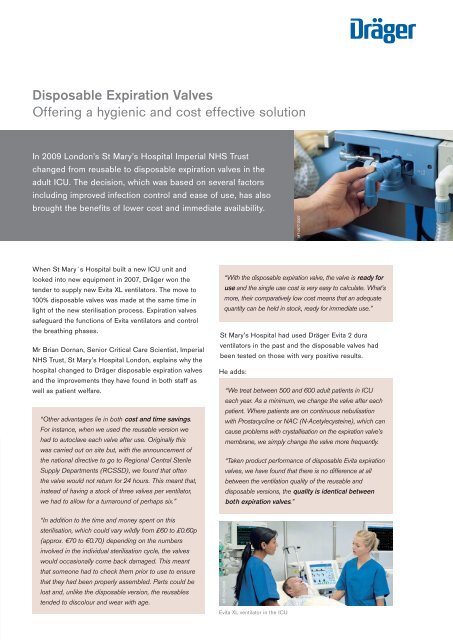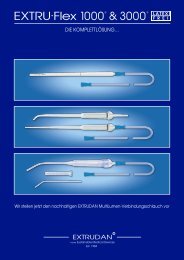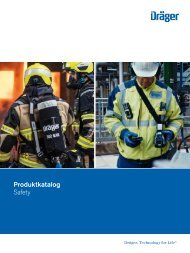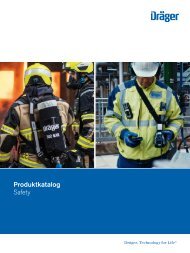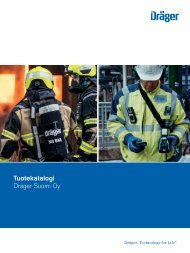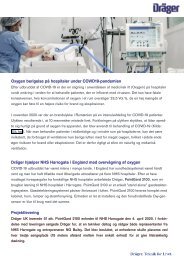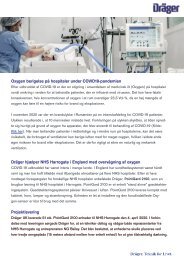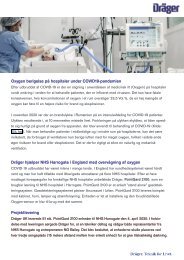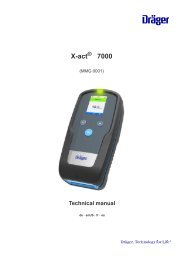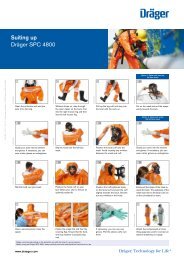ICU-Case Study_Dräger Expiration Valve_DICU_CS
Create successful ePaper yourself
Turn your PDF publications into a flip-book with our unique Google optimized e-Paper software.
Disposable <strong>Expiration</strong> <strong>Valve</strong>s<br />
Offering a hygienic and cost effective solution<br />
In 2009 London’s St Mary’s Hospital Imperial NHS Trust<br />
changed from reusable to disposable expiration valves in the<br />
adult <strong>ICU</strong>. The decision, which was based on several factors<br />
including improved infection control and ease of use, has also<br />
brought the benefits of lower cost and immediate availability.<br />
MT-0677-2007<br />
When St Mary´s Hospital built a new <strong>ICU</strong> unit and<br />
looked into new equipment in 2007, <strong>Dräger</strong> won the<br />
tender to supply new Evita XL ventilators. The move to<br />
100% disposable valves was made at the same time in<br />
light of the new sterilisation process. <strong>Expiration</strong> valves<br />
safeguard the functions of Evita ventilators and control<br />
the breathing phases.<br />
Mr Brian Dornan, Senior Critical Care Scientist, Imperial<br />
NHS Trust, St Mary’s Hospital London, explains why the<br />
hospital changed to <strong>Dräger</strong> disposable expiration valves<br />
and the improvements they have found in both staff as<br />
well as patient welfare.<br />
“Other advantages lie in both cost and time savings.<br />
For instance, when we used the reusable version we<br />
had to autoclave each valve after use. Originally this<br />
was carried out on site but, with the announcement of<br />
the national directive to go to Regional Central Sterile<br />
Supply Departments (R<strong>CS</strong>SD), we found that often<br />
the valve would not return for 24 hours. This meant that,<br />
instead of having a stock of three valves per ventilator,<br />
we had to allow for a turnaround of perhaps six.”<br />
“With the disposable expiration valve, the valve is ready for<br />
use and the single use cost is very easy to calculate. What’s<br />
more, their comparatively low cost means that an adequate<br />
quantity can be held in stock, ready for immediate use.”<br />
St Mary’s Hospital had used <strong>Dräger</strong> Evita 2 dura<br />
ventilators in the past and the disposable valves had<br />
been tested on those with very positive results.<br />
He adds:<br />
“We treat between 500 and 600 adult patients in <strong>ICU</strong><br />
each year. As a minimum, we change the valve after each<br />
patient. Where patients are on continuous nebulisation<br />
with Prostacycline or NAC (N-Acetylecysteine), which can<br />
cause problems with crystallisation on the expiration valve’s<br />
membrane, we simply change the valve more frequently.<br />
“Taken product performance of disposable Evita expiration<br />
valves, we have found that there is no difference at all<br />
between the ventilation quality of the reusable and<br />
disposable versions, the quality is identical between<br />
both expiration valves.”<br />
“In addition to the time and money spent on this<br />
sterilisation, which could vary wildly from £60 to £0.60p<br />
(approx. €70 to €0.70) depending on the numbers<br />
involved in the individual sterilisation cycle, the valves<br />
would occasionally come back damaged. This meant<br />
that someone had to check them prior to use to ensure<br />
that they had been properly assembled. Parts could be<br />
lost and, unlike the disposable version, the reusables<br />
tended to discolour and wear with age.<br />
MT-1524-2008<br />
Evita XL ventilator in the <strong>ICU</strong>
2<br />
MT-4812-2008<br />
MT-4837-2008<br />
Changing the Disposable <strong>Expiration</strong> <strong>Valve</strong><br />
Disposable <strong>Expiration</strong> <strong>Valve</strong> for Evita ventilators<br />
He continues:<br />
“There are a number of advantages associated with<br />
disposability, particularly where the prevention of<br />
cross contamination is concerned. In terms of<br />
the patient benefit, the valve has not been used by<br />
another patient and the risk of infection transfer<br />
is minimised. For the nursing staff, the daily routine<br />
is made safer and easier because the disposable<br />
expiration valve requires no assembly.<br />
“Ensuring that infection control and hygiene<br />
standards are met, the valve is easily and quickly<br />
replaced for each patient and then is just as easily<br />
disposed of. As far as I am concerned, by using the<br />
<strong>Dräger</strong> disposable expiration valve I know that I<br />
have gone as far as I can to prevent an infection.”<br />
With the number of nosocomial infections on the<br />
increase, the use of disposable valves is breaking<br />
new ground in reducing labour intensive reprocessing<br />
costs, improving infection control and saving time<br />
whilst maintaining the very best hygienic conditions.<br />
Mr Dornan concludes:<br />
“The average cost of stay per patient on the <strong>ICU</strong><br />
is £2,500 (approx. €2,900) per day. Compared to<br />
the quantity of cost of care the cost per single<br />
disposable Evita expiration valve is not a lot. It is a<br />
cost, but again it is worth the safety.<br />
“Our statistics for ventilator associated pneumonia<br />
(VAP) at St Mary’s is well below the average<br />
national UK value and I certainly feel happier in<br />
the knowledge that patients and staff are<br />
properly protected.”
3<br />
medicine revolution, pressure on bed occupancy relaxed,<br />
and with the formation of the NHS in the 1940’s, many<br />
of the local hospitals of the St Mary’s teaching hospital<br />
group eventually closed and relocated services to the<br />
Paddington basin site.<br />
Since the UK’s first academic health science centre<br />
was created in 2008, it is operated by Imperial College<br />
Healthcare NHS Trust.<br />
St Mary’s Hospital<br />
HISTORY<br />
St Mary’s Hospital is a hospital located in Paddingtion,<br />
London, England that was founded in 1845. This hospital<br />
first opened its doors to patients in 1851, the last of the<br />
great voluntary hospitals to be founded.<br />
With the shift towards community healthcare delivered<br />
in the early 20th century, partly due to the social<br />
CRITICAL CARE AT ST MARY’S HOSPITAL<br />
The adult intensive care unit (A<strong>ICU</strong>) with 16 <strong>Dräger</strong><br />
Evita XL ventilators at St Mary’s provides specialist<br />
care for critically ill adult patients.<br />
The intensive care team comprises intensive care<br />
consultants, medical trainees, intensive care nurses,<br />
physiotherapists, a pharmacist and a dietician.<br />
The A<strong>ICU</strong> consultants provide continuous dedicated<br />
cover to the unit with all requests for admission referred<br />
to the A<strong>ICU</strong> consultant on duty.<br />
Mr Brian Dornan<br />
Senior Critical Care Scientist<br />
Imperial NHS Trust<br />
Adult <strong>ICU</strong><br />
St. Mary’s Hospital<br />
South Wharfe Road<br />
Paddington<br />
London W2 1NY<br />
Mr. Brian Dornan started working in St. Mary’s theatres<br />
in 1988. He has worked in Critical Care for 21 years.<br />
Mr Brian Dornan
4<br />
90 67 246 | 1 2.11-1 | Marketing Communications | <strong>CS</strong> | PR | LE | Printed in the UK | Chlorine-free – environmentally compatible | Subject to modifications | © 2011 <strong>Dräger</strong>werk AG & Co. KGaA<br />
CORPORATE HEADQUARTERS<br />
<strong>Dräger</strong>werk AG & Co. KGaA<br />
Moislinger Allee 53–55<br />
23558 Lübeck, Germany<br />
www.draeger.com<br />
REGION EUROPE CENTRAL<br />
AND EUROPE NORTH<br />
<strong>Dräger</strong> Medical GmbH<br />
Moislinger Allee 53–55<br />
23558 Lübeck, Germany<br />
Tel +49 451 882 0<br />
Fax +49 451 882 2080<br />
info@draeger.com<br />
REGION MIDDLE EAST, AFRICA,<br />
CENTRAL AND SOUTH AMERICA<br />
<strong>Dräger</strong> Medical GmbH<br />
Branch Office Dubai<br />
Dubai Healthcare City, P.O. Box 505108<br />
Dubai, United Arab Emirates<br />
Tel + 971 436 24 762<br />
Fax + 971 436 24 761<br />
contactuae@draeger.com<br />
Manufacturer:<br />
<strong>Dräger</strong> Medical GmbH<br />
23542 Lübeck, Germany<br />
The quality management system at<br />
<strong>Dräger</strong> Medical GmbH is certified<br />
according to ISO 13485, ISO 9001<br />
and Annex II.3 of Directive 93/42/EEC<br />
(Medical devices).<br />
REGION EUROPE SOUTH<br />
<strong>Dräger</strong> Médical S.A.S.<br />
Parc de Haute<br />
Technologie d’Antony 2<br />
25, rue Georges Besse<br />
92182 Antony Cedex, France<br />
Tel +33 146115600<br />
Fax +33 140 96 97 20<br />
dlmfr-contact@draeger.com<br />
REGION ASIA / PACIFIC<br />
Draeger Medical<br />
South East Asia Pte Ltd<br />
25 International Business Park<br />
#04-27/29 German Centre<br />
Singapore 609916, Singapore<br />
Tel +65 6572 4388<br />
Fax +65 6572 4399<br />
asia.pacific@draeger.com


